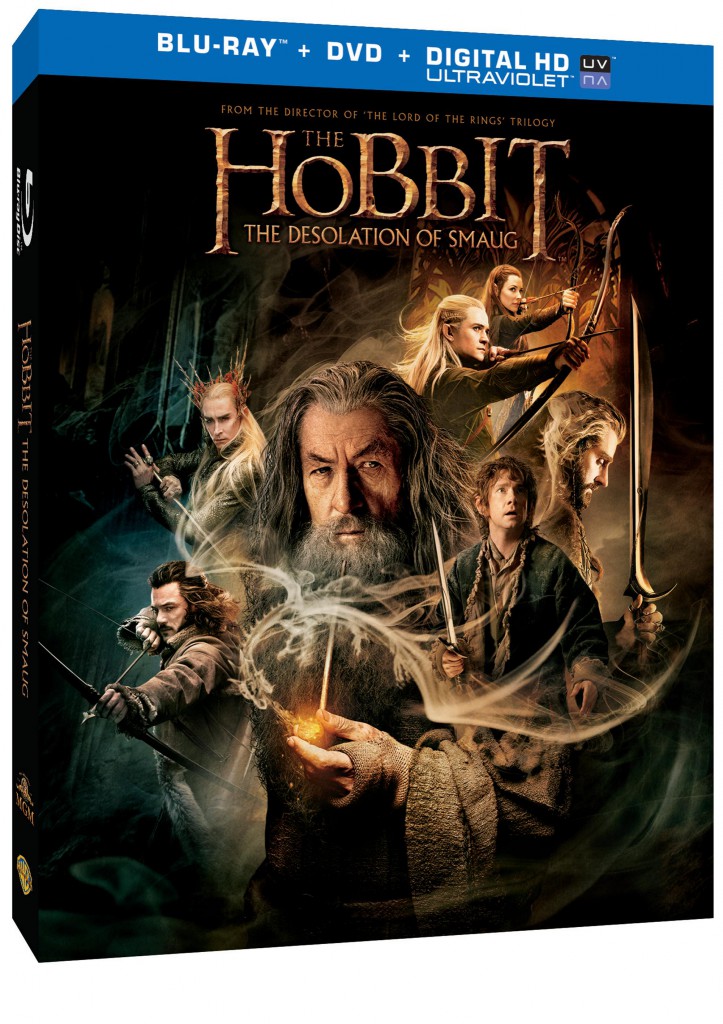 Blu-ray.com has posted their review of the 2D Blu-ray release of The Hobbit: The Desolation of Smaug. High marks are given for both video (4.5 out of 5) and audio quality (5 out of 5) – and we also get a closer glimpse at what bonus features are offered on this Theatrical Blu-ray/DVD edition.
Blu-ray.com has posted their review of the 2D Blu-ray release of The Hobbit: The Desolation of Smaug. High marks are given for both video (4.5 out of 5) and audio quality (5 out of 5) – and we also get a closer glimpse at what bonus features are offered on this Theatrical Blu-ray/DVD edition.
Of particular note is the inclusion of last year’s The Desolation of Smaug Live Event, as well as a collection of trailers for the film (both of which were previously unadvertised for this release). Continue reading “Blu-ray.com reviews ‘The Hobbit: The Desolation of Smaug’ 2D Blu-ray release”
Posted in:
Share:

 For those hoping for more pick-ups for The Hobbit, it seems as though we’ve reached the end. In an interview in Las Vegas, Richard Armitage indicated that filming was complete, with only motion capture and ADR work left to be done.
For those hoping for more pick-ups for The Hobbit, it seems as though we’ve reached the end. In an interview in Las Vegas, Richard Armitage indicated that filming was complete, with only motion capture and ADR work left to be done.
Continue reading “No pick-up filming as Jackson prepares to farewell Middle-earth”
Posted in:
Share:

Warner Bros. has been flogging the digital and blu-ray release of The Hobbit: The Desolation of Smaug (theatrical edition) via a little mini-site called TheHobbitCountdown.
It also boasts a rotating stable of wallpapers that seem to change every day or so. Here are four of the recent ones.
Continue reading “New Hobbit wallpapers from TheHobbitCountdown.com”
Posted in:
Share:

 We’ve reached arguably the most exciting round of this year’s Middle-earth March Madness – The Elite Eight! Eight combatants have tested their gruff against some impressive opponents, and now face a battle for the ages! In the Lonely Mountain division we have the (16) Elrond taking on fan fav (6) Aragorn. In Erebor, (1) Thorin Oakenshield faces a much bigger challenge than gold fever when he faces (3) The One Ring. The Bag End match-up is a battle of the top seeds as (1) Bilbo takes on the trending (2) Thranduil (aka Sparkles). And last but not least, Mirkwood gives us a battle of two all-time Middle-earth juggernauts – (1) Gandalf vs. (14) Legolas. This is a round for the ages!
We’ve reached arguably the most exciting round of this year’s Middle-earth March Madness – The Elite Eight! Eight combatants have tested their gruff against some impressive opponents, and now face a battle for the ages! In the Lonely Mountain division we have the (16) Elrond taking on fan fav (6) Aragorn. In Erebor, (1) Thorin Oakenshield faces a much bigger challenge than gold fever when he faces (3) The One Ring. The Bag End match-up is a battle of the top seeds as (1) Bilbo takes on the trending (2) Thranduil (aka Sparkles). And last but not least, Mirkwood gives us a battle of two all-time Middle-earth juggernauts – (1) Gandalf vs. (14) Legolas. This is a round for the ages!
Voting in this round will end on April 1st (we promise to give you real results) so don’t delay – fight for your choices. Share! Tweet! Comment!
Continue reading “We’ve reached the Elite Eight! Vote Now in Middle-earth March Madness Round 4!”
Posted in:
Share:

 Welcome to this months “Getting to know you” Q&A, this month we’re talking to the wonderful Royd Tolkien.
Welcome to this months “Getting to know you” Q&A, this month we’re talking to the wonderful Royd Tolkien.
I received a lot of questions for Royd, which I have divided into three sections, reflecting peoples main areas of interest. I hope you enjoy the interview as much as I did conducting it. Cheers Kel x
Continue reading “Getting to know Royd Tolkien”
Posted in:
Share:

 People hoping for a big reveal about The Hobbit: There and Back Again at CinemaCon 2014 will probably come away disappointed by the news that, well, there wasn’t much news at all on that front.
People hoping for a big reveal about The Hobbit: There and Back Again at CinemaCon 2014 will probably come away disappointed by the news that, well, there wasn’t much news at all on that front.
Warner Bros. closed out their 2.30pm presentation with a special recorded message from Peter Jackson, then rolled a new production diary. Continue reading “CinemaCon Hobbit presentation reveals (un)-surprisingly little”
Posted in:
Share:

 Blu-ray.com has posted their review of the 2D Blu-ray release of The Hobbit: The Desolation of Smaug. High marks are given for both video (4.5 out of 5) and audio quality (5 out of 5) – and we also get a closer glimpse at what bonus features are offered on this Theatrical Blu-ray/DVD edition.
Blu-ray.com has posted their review of the 2D Blu-ray release of The Hobbit: The Desolation of Smaug. High marks are given for both video (4.5 out of 5) and audio quality (5 out of 5) – and we also get a closer glimpse at what bonus features are offered on this Theatrical Blu-ray/DVD edition.


 For those hoping for more pick-ups for The Hobbit, it seems as though we’ve reached the end. In an interview in Las Vegas, Richard Armitage indicated that filming was complete, with only motion capture and ADR work left to be done.
For those hoping for more pick-ups for The Hobbit, it seems as though we’ve reached the end. In an interview in Las Vegas, Richard Armitage indicated that filming was complete, with only motion capture and ADR work left to be done. We’ve reached arguably the most exciting round of this year’s Middle-earth March Madness – The Elite Eight! Eight combatants have tested their gruff against some impressive opponents, and now face a battle for the ages! In the Lonely Mountain division we have the (16) Elrond taking on fan fav (6) Aragorn. In Erebor, (1) Thorin Oakenshield faces a much bigger challenge than gold fever when he faces (3) The One Ring. The Bag End match-up is a battle of the top seeds as (1) Bilbo takes on the trending (2) Thranduil (aka Sparkles). And last but not least, Mirkwood gives us a battle of two all-time Middle-earth juggernauts – (1) Gandalf vs. (14) Legolas. This is a round for the ages!
We’ve reached arguably the most exciting round of this year’s Middle-earth March Madness – The Elite Eight! Eight combatants have tested their gruff against some impressive opponents, and now face a battle for the ages! In the Lonely Mountain division we have the (16) Elrond taking on fan fav (6) Aragorn. In Erebor, (1) Thorin Oakenshield faces a much bigger challenge than gold fever when he faces (3) The One Ring. The Bag End match-up is a battle of the top seeds as (1) Bilbo takes on the trending (2) Thranduil (aka Sparkles). And last but not least, Mirkwood gives us a battle of two all-time Middle-earth juggernauts – (1) Gandalf vs. (14) Legolas. This is a round for the ages! Welcome to this months “Getting to know you” Q&A, this month we’re talking to the wonderful Royd Tolkien.
Welcome to this months “Getting to know you” Q&A, this month we’re talking to the wonderful Royd Tolkien. People hoping for a big reveal about The Hobbit: There and Back Again at CinemaCon 2014 will probably come away disappointed by the news that, well, there wasn’t much news at all on that front.
People hoping for a big reveal about The Hobbit: There and Back Again at CinemaCon 2014 will probably come away disappointed by the news that, well, there wasn’t much news at all on that front.